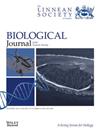Mixed mating patterns in morphologically diverse bumblebee-pollinated Salvia species from China
IF 1.5
3区 生物学
Q3 EVOLUTIONARY BIOLOGY
引用次数: 0
Abstract
Flowers of Salvia are characterized by a diversity of staminal lever types mediating pollen transfer. In the East Asian subgenus Glutinaria, species have been categorized based on their distinct flower and stamen morphologies. A hypothesized advantage of degraded-lever types suggests they may optimize pollinator foraging time, increase visitation rates, and potentially trigger autonomous self-pollination. However, this hypothesis remains untested. Here, Salvia castanea, S. miltiorrhiza, and S. liguliloba were selected as test species representing the three major flower and stamen types of the East Asian sages. We compared the species with regard to their inflorescence architecture, floral display, nectar reward, pollinator efficiency, and seed set. We found that S. liguliloba had a degraded-lever type that significantly reduced pollinator foraging time did not significantly increase pollination efficiency. These species have a mixed mating pattern with high seed set, no pollen- or pollinator limitation, and no inbreeding depression. We conclude that the diversity of floral traits is addressed to pollinators, whereas reproductive success emerges from a complex interplay of factors encompassing floral characteristics, pollination efficiency, plant life history, or/and other biotic and abiotic factors. For this reason, the link between floral morphological traits and mating systems should not overestimated.中国不同大黄蜂传粉鼠尾草种的混合交配模式
鼠尾草花的特点是雄蕊杠杆类型的多样性介导花粉传递。在东亚的谷草亚属中,根据其独特的花和雄蕊形态进行了物种分类。退化杠杆类型的一个假设优势表明,它们可能优化传粉者的觅食时间,增加访问率,并可能触发自主自花授粉。然而,这一假设尚未得到验证。本研究以丹参、丹参和木犀草为试验种,分别代表东亚三种主要的花蕊类型。我们比较了这些物种的花序结构、花的展示、花蜜的回报、传粉者的效率和种子的结实率。研究发现,木叶橐吾属退化杠杆型,显著减少传粉者的觅食时间,但不显著提高传粉效率。这些物种具有高结实率的混合交配模式,没有花粉或传粉者的限制,没有近交抑制。我们的结论是,花性状的多样性是针对传粉者的,而生殖成功则是包括花特性、授粉效率、植物生活史或/和其他生物和非生物因素在内的复杂相互作用的结果。因此,不应过高估计花形态特征与交配系统之间的联系。
本文章由计算机程序翻译,如有差异,请以英文原文为准。
求助全文
约1分钟内获得全文
求助全文
来源期刊
CiteScore
4.30
自引率
10.50%
发文量
140
审稿时长
3-6 weeks
期刊介绍:
The Biological Journal of the Linnean Society is a direct descendant of the oldest biological journal in the world, which published the epoch-making papers on evolution by Darwin and Wallace. The Journal specializes in evolution in the broadest sense and covers all taxonomic groups in all five kingdoms. It covers all the methods used to study evolution, whether whole-organism or molecular, practical or theoretical.d.

 求助内容:
求助内容: 应助结果提醒方式:
应助结果提醒方式:


